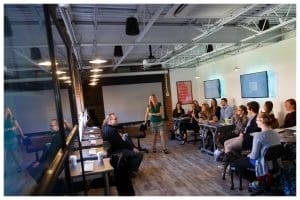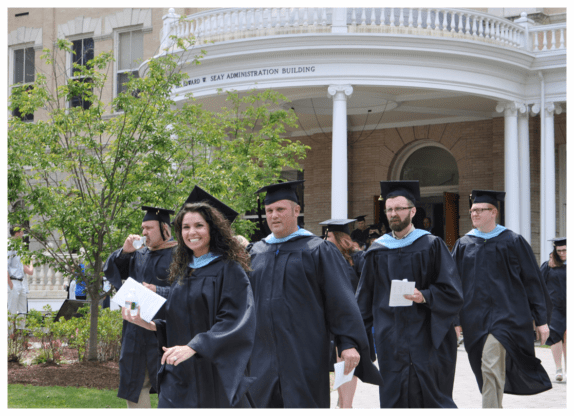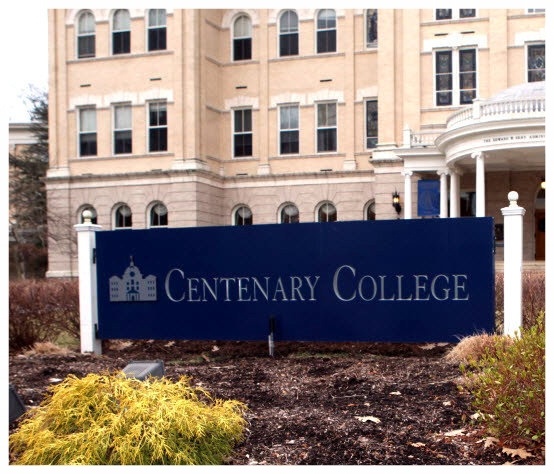Ever been on a sinking ship? That was the state of Centenary College when Dr. Kenneth L. Hoyt took over as president in 2001.
To say the Hackettstown, NJ academic institution was in serious financial trouble was an understatement. Enrollment was declining, annual deficits were large and getting larger, fundraising was stagnant, the facilities were old and crumbling, and student retention was terrible (only half of first-year students returned to become sophomores). What’s more, from a recruitment standpoint, the college was virtually unknown among high school counselors. No way to go but up, right?
That’s exactly what Dr. Hoyt did. As I detail in my book, “On the Brink: A Fresh Lens to Take Your Business to New Heights,” by the time Hoyt left in 2009, Centenary had become the fastest-growing college or university in New Jersey.
He increased undergraduate, adult and graduate enrollment from 700 to 3,200; secured $45.5 million for new facilities, programs and endowment; constructed a new student and performing arts center, a new technology building, new athletic facilities and two new dorms; and doubled the land area of the college.
How did Hoyt pull it off? In short, by stripping down and then rebuilding Centenary’s brand message — identifying what made Centenary “Centenary” — and then broadcasting it far and wide. Guess what? It worked, transforming this sleepy, liberal arts college into a thriving, innovative powerhouse.
Can you do the same for your stalled business? You sure can! Here’s how.
I often say, if you want to change, have a crisis.
It was indeed crisis time for Centenary when Hoyt arrived in 2001. The college was known as a two-year women’s finishing school with an equestrian program and a limited course curriculum focused on teacher education. For most of its students, Centenary was their only choice and they planned to transfer out as soon as possible.
Hoyt quickly recognized that just about everything about Centenary needed to change, from the culture to the teaching models to the facilities to the abysmal retention rates to recruitment to…you get the idea. To accomplish this massive brand reimagining, he promoted in-house talent and hired outside ones (myself included) to rethink and rebuild the college. Plus, he identified areas needing immediate investment, particularly technology, if Centenary was to become a leader in educating a new generation of students for the jobs of today and tomorrow.
A two-part overhaul to get Centenary back on track.
As a consultant, my assignment was two-fold:
- To clarify the “Centenary Student.” What kind of person would thrive in this small liberal arts college which was now investing in new programs to better meet his or her needs?
- To convert my findings into brand positioning that differentiated Centenary from other schools and then help leadership build the brand, market the college and create demand.
As an anthropologist, I approached these two tasks like an anthropological research project, seeking to experience Centenary as if I was a student there.
I hung out on campus — a lot. I went to classes and observed, watched faculty interact during meetings and listened to students as they went about their day. What I was trying to discover  was the core personality of the college so I could answer the crucial questions: Why Centenary, what made it different from other colleges, and what, if anything, was it doing well?
was the core personality of the college so I could answer the crucial questions: Why Centenary, what made it different from other colleges, and what, if anything, was it doing well?
I invite you to try these same techniques as a way of identifying your own company’s essence. Go out in the field and mingle with your customers. What are they saying? How are they interacting with your product or service? Are they satisfied or frustrated? Then ask yourself, what makes us different? What are we doing well? What could we do better? What unmet need could we capitalize on that we’re ignoring?
The brand was real. It just had to come alive.
In Centenary’s case, I found that teachers were actually doing a great deal that was different and that innovatively created value for their students. From that insight, a theme began to take shape: “Education designed around you.”
The more I observed, and listened, the clearer the distinctions from other colleges became. At Centenary, students received an inordinate amount of individual attention. They regularly spent time with faculty in their offices, asking questions, weighing their career options, getting academic help, “shooting the breeze.” I felt that we were onto something, but it needed to be packaged into a consistent brand positioning that could be easily communicated.
A second theme that kept popping up was the tremendous pride the faculty felt in how they taught their students to “teach how students learn.” And still a third theme, expressed by the students, was a yearning to “belong.” They strongly wanted to feel a part of what was becoming the college’s new message: “The Centenary Experience: An Education Designed Around You.”
Once we’d found the story, we needed to tell it loudly and well.
As things began to shift in a positive direction at Centenary — new buildings, new faculty, new programs for non-traditional (adult) students — so did the values, beliefs and behavior — the culture — of the institution. Day by day, Centenary was being rebuilt in both a physical and cultural sense.
So how could we take the essence of what the administration, faculty and students were already living and create messaging that captured the story?
First, we settled on the message (“The Centenary Experience: An Education Designed Around You”). Then we figured out how to make it come alive. And by the way, how we did it easily applies to any business that needs to communicate a new brand strategy – even its current strategy — and move forward for growth.
Our new communication strategy was fourfold:
- We put the proprietary notion that Centenary “teaches you the way you learn” front and center in all communications.
- We emphasized the fact that the college was an early adopter in the use of the Internet and wireless technology in its classrooms, providing laptops to all faculty, staff and students. (This was a huge differentiator. At the time, Centenary was one of only 100 such institutions to do so, causing it to be selected in 2005 by both Intel and Forbes as one of the Top 50 Wireless Campuses in the U.S.)
- We launched a major advertising campaign throughout New Jersey to build the brand identity and shift attitudes about the college among students, parents and high school counselors.
- We built Centenary’s first website (with a student who was learning to code), syncing the online brand positioning with what we were saying out in the marketplace.
When branding your company, product or service, there must be a common thread.
In everything we did to build Centenary’s brand persona, we asked ourselves, “How is this heightening understanding of why Centenary is a college education students should consider?” By staying true to the core brand message — “The Centenary Experience: An Education Designed Around You” — we were able to successfully reposition this stalled, little-known academic institution as a nationally-recognized, independent college that taught you the way you best learned and successfully prepared students for careers after college.
What can you learn from Centenary College for your business?
Dr. Hoyt left Centenary in 2009, having accomplished the turnaround he’d envisioned. But even more important than all the new buildings and programs and dorms he caused to be built, he gave the college something that your business might also find of great value: a new way to think about its role in the lives of the people it served.
 Centenary’s mission was to produce well-prepared students who could thrive throughout their adult lives, long after leaving college. What might this mean for your organization? A suggestion: like Centenary, build your mission backwards, determining what the needs of your customers are and then figuring out the best ways to satisfy them.
Centenary’s mission was to produce well-prepared students who could thrive throughout their adult lives, long after leaving college. What might this mean for your organization? A suggestion: like Centenary, build your mission backwards, determining what the needs of your customers are and then figuring out the best ways to satisfy them.
Perhaps this is a good time for you to rethink your business, including your brand and how you’re living it (or not) internally and externally. Like Dr. Hoyt, are you ready to make fundamental changes if you find the old models aren’t working? Change is never easy but in Centenary’s case, it was the only option. Maybe dramatic change is the best way forward for you, too.
(All photos courtesy of centenaryuniversity.edu)
3 blogs on how to realign your brand story and dramatically grow your business
In order to build a successful business, a compelling, proprietary brand story is not just important, it’s critical. At Simon Associates Management Consultants (SAMC), we work with clients whose businesses have stalled and whose brand message needs to be examined, possibly overhauled, and clearly communicated to consumers. Here are three of our recent blogs on specifically how we do that:
- Your Brand Story: What Does It Say About You And Is Anybody Listening?
- 5 Ways to Find New Customers. They Are All Around You!
- Easy-to-Use Anthropology Toolkit to Grow Your Business
Business stalled? Need to grow? Contact us.
You might find one of our workshops will help you rethink your current brand story and better position your company for growth.
From Observation to Innovation,

Andi Simon, Ph.D.
President and CEO | Corporate Anthropologist
Simon Associates Management Consultants
Info@simonassociates.net
@simonandi



